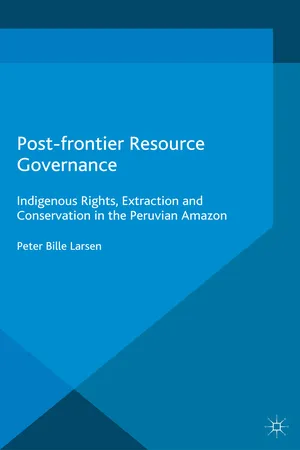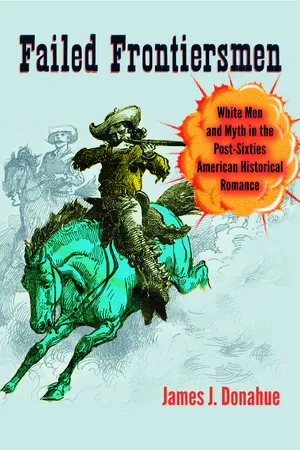Literature
Frontier Novels
Frontier novels are a genre of American literature that emerged in the late 19th and early 20th centuries. They typically depict the struggles and adventures of pioneers and settlers in the American West, often featuring themes of individualism, self-reliance, and the conquest of nature. Notable examples include "The Last of the Mohicans" by James Fenimore Cooper and "My Antonia" by Willa Cather.
Written by Perlego with AI-assistance
Related key terms
Related key terms
1 of 4
Related key terms
1 of 3
3 Key excerpts on "Frontier Novels"
- eBook - ePub
Post-frontier Resource Governance
Indigenous Rights, Extraction and Conservation in the Peruvian Amazon
- P. Larsen(Author)
- 2016(Publication Date)
- Palgrave Macmillan(Publisher)
3 Frontier Narratives Introductionthe frontiers of civilization seldom present an attractive face, even to the unprejudiced eye. All over the planet a very real frontier conflict is being played out in these barely civilized places … the frontlines are invariably a desolate sight. Settled amid the anarchy of everything provisional and, in many cases, beyond the reach of national law … their mongrel nature is perhaps more distinct in Amazonia than anywhere else … thousands of identical little towns mushroom endlessly, each day putting out new tentacles, each day increasingly ramshackle and still without the power to swallow up the great hybrid to elicit sympathy, these towns of corrugated iron convey a degenerate image of all the worlds that they bring into confrontation. It is in one of these gloomy observation posts that ethnographic research usually begins.(Descola 1986: 1)In the above quote, one can almost hear anthropologist Philippe Descola sigh impatiently in Puyo, Ecuador, “a world”, he added, “without any real past”, before departing for his well-known study of the Jivaros. Ideas of frontier “boom” societies as half-cooked, deficient, temporary and unappealing are common in the anthropological trope to counter centuries of frontier optimism. While such counter-narratives challenge dominant tropes, they do little justice to the specific historical dynamics and narratives underscoring frontier expansion. As Tsing herself asks, “How does nature at the frontier become a set of resources? How are landscapes made empty and wild so that anyone can come to use and claim them?” (Tsing 2005: 30). This chapter suggests careful attention to the cultural production involved in creating frontiers and legitimating particular forms of frontier agency and intervention. This is particularly relevant in the Amazon, where resource abundance is frequently listed as an obvious or naturalized property despite decades of critique. Careful attention is, in other words, needed to address the specific processes reconfiguring certain places in terms of both resource abundancy and frontier permeability. Frontier creation is not simply the result of labour, capital and resources adding up in economic terms, but relies on narrative configurations of people and places that permit, attract and incite. Frontier narratives “open” up areas, whereas post-frontier narratives nominally close them. Such frontier narratives, particularly when presented in a state expansion context, involve linear projections of social change, the mobilization of certain forms of knowledge and the protagonism of external agency. This chapter offers an alternative to the common anthropological critique of frontiers as spaces of social, cultural and environmental disorder. Building on historical and ethnographic material spanning the 18th to the 20th century, the chapter zooms in on different moments in the history of Oxapampa Province in the Peruvian Amazon to explore the nature and significance of frontier narratives. Particular focus is on the intertwined roles of scientific description, entrepreneurialism and state expansion in carving out distinct frontier places and forms of action. In contrast with narratives emphasizing frontiers as spaces of disorder and the absence of regulation, the chapter underlines the significance of ordering devices in both environmental and social terms. The chapter also serves as a historical introduction for the book as a whole. - eBook - ePub
Cultural Frames, Framing Culture
White Men and Myth in the Post-Sixties American Historical Romance
- James J. Donahue(Author)
- 2015(Publication Date)
- University of Virginia Press(Publisher)
They were not the captives of their own doubts, the prisoners of their own price tags. Their motto was not ‘every man for himself’—but ‘all for the common cause.’ They were determined to make that new world strong and free, to overcome its hazards and its hardships, to conquer the enemies that threatened from without and within. Today some would say that those struggles are all over—that all the horizons have been explored—that all the battles have been won—that there is no longer an American frontier.” 65 Both of these notions—the frontier as dead history and the frontier as active topos—play against each other in much American literature published after 1960. This interplay is so pervasive that even while employing the frontier as positive space, Senator Kennedy recognizes that victories on the frontier came as a result of battles, referencing the violence implicit in the “taming” of the western lands. (One should recall a similar sentiment expressed by Theodore Roosevelt, another man who would become the U.S. president.) The literature of the period will be shown to address directly the notion that the positive, progressive aspects of the frontier came as a result of the violence inflicted by warfare and attempted genocide. This far-from-neutral ground is the space whereby American values originated and have since been defined by American mythmakers. The social and cultural destruction caused by westward expansion was not systematically addressed in Turner’s work - eBook - ePub
Exploring the Next Frontier
Vietnam, NASA, Star Trek and Utopia in 1960s and 70s American Myth and History
- Matthew Wilhelm Kapell(Author)
- 2016(Publication Date)
- Routledge(Publisher)
They were far more interested in a New Left version of more traditional historical research. They still understood the “west” or “frontier” had a mythic component and did discuss that aspect of western history. But their interests lay in understanding something that, with a dose of postmodern relativism included, could still be understood as “factual” and “true” about the “real” history of the American West. This book is less about what is “historically true” than it is about what is mythologically true. Thus, there are no arguments to be had with empirical historians because it is a work more interested in cultural inventions. As Eric Hayne notes, the west “did not have to be inhabited so much as invented” and as a result its invention still reverberates through American cultural models (1992, 4). It is easy to see the continuing significance of frontier ideology and the Turner Thesis in all areas of American culture. The western genre novels beginning with Owen Wister and developing through Zane Grey, Louis L’Amour, and others are obvious examples. But the romance genre consists of an entire subgenre of “historical romance” that almost exclusively deals with the myths of the American west (Singly 1992 deals with a specific example of this; Kapell and Becker [2005] offers an analysis of the Christian themes of such works). Science fiction, both written and visual, is often defined as a genre of (in the opening phrase of Star Trek), “the Final Frontier” linking, in the words of American literary historian David Mogen, “the romance of space travel … with the romance of earlier frontier literature” (1993, 16). Even many computer “strategy games” operate through the idea of conquering a frontier, be it on Earth or on the “final frontier” of space (M
Index pages curate the most relevant extracts from our library of academic textbooks. They’ve been created using an in-house natural language model (NLM), each adding context and meaning to key research topics.
Explore more topic indexes
Explore more topic indexes
1 of 6
Explore more topic indexes
1 of 4


